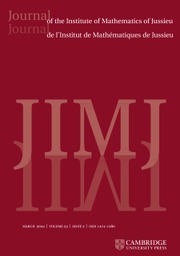Article contents
TEST IDEALS IN RINGS WITH FINITELY GENERATED ANTI-CANONICAL ALGEBRAS
Published online by Cambridge University Press: 13 January 2016
Abstract
Many results are known about test ideals and  $F$ -singularities for
$F$ -singularities for  $\mathbb{Q}$ -Gorenstein rings. In this paper, we generalize many of these results to the case when the symbolic Rees algebra
$\mathbb{Q}$ -Gorenstein rings. In this paper, we generalize many of these results to the case when the symbolic Rees algebra  ${\mathcal{O}}_{X}\oplus {\mathcal{O}}_{X}(-K_{X})\oplus {\mathcal{O}}_{X}(-2K_{X})\oplus \cdots \,$ is finitely generated (or more generally, in the log setting for
${\mathcal{O}}_{X}\oplus {\mathcal{O}}_{X}(-K_{X})\oplus {\mathcal{O}}_{X}(-2K_{X})\oplus \cdots \,$ is finitely generated (or more generally, in the log setting for  $-K_{X}-\unicode[STIX]{x1D6E5}$ ). In particular, we show that the
$-K_{X}-\unicode[STIX]{x1D6E5}$ ). In particular, we show that the  $F$ -jumping numbers of
$F$ -jumping numbers of  $\unicode[STIX]{x1D70F}(X,\mathfrak{a}^{t})$ are discrete and rational. We show that test ideals
$\unicode[STIX]{x1D70F}(X,\mathfrak{a}^{t})$ are discrete and rational. We show that test ideals  $\unicode[STIX]{x1D70F}(X)$ can be described by alterations as in Blickle–Schwede–Tucker (and hence show that splinters are strongly
$\unicode[STIX]{x1D70F}(X)$ can be described by alterations as in Blickle–Schwede–Tucker (and hence show that splinters are strongly  $F$ -regular in this setting – recovering a result of Singh). We demonstrate that multiplier ideals reduce to test ideals under reduction modulo
$F$ -regular in this setting – recovering a result of Singh). We demonstrate that multiplier ideals reduce to test ideals under reduction modulo  $p$ when the symbolic Rees algebra is finitely generated. We prove that Hartshorne–Speiser–Lyubeznik–Gabber-type stabilization still holds. We also show that test ideals satisfy global generation properties in this setting.
$p$ when the symbolic Rees algebra is finitely generated. We prove that Hartshorne–Speiser–Lyubeznik–Gabber-type stabilization still holds. We also show that test ideals satisfy global generation properties in this setting.
Information
- Type
- Research Article
- Information
- Journal of the Institute of Mathematics of Jussieu , Volume 17 , Issue 1 , February 2018 , pp. 171 - 206
- Copyright
- © Cambridge University Press 2016
References
A correction has been issued for this article:
- 9
- Cited by
Linked content
Please note a has been issued for this article.

